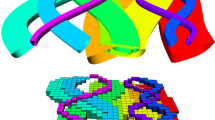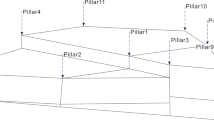Abstract
This paper presents a method for tetrahedral mesh generation for subsurface reservoir structural modeling based on sequentially cutting an input tetrahedral grid with geological surfaces represented by implicit functions. Most of the existing literature on meshing to implicit surfaces mainly focuses on independent closed surfaces, making it hardly applicable to subsurface structural modeling where, in addition to occasional closed surfaces (e.g., detached salt diapirs), the subsurface model is typically made of a mixture of multiple intersecting finite surfaces (e.g., faults) and infinite surfaces (e.g., horizons). This peculiar setting sometimes makes it challenging to build a sealed structural surface model (i.e., a boundary representation model), which is the starting point of traditional, but also challenging, constrained Delaunay solid mesh generation. The method presented herein bypasses the creation of a sealed surface model and generates a solid mesh directly from point sets and/or a set of topologically disconnected surfaces; the sealed surface model is obtained as a byproduct, if needed.


















Similar content being viewed by others
References
Alliez P, Cohen-Steiner D, Yvinec M, Desbrun M (2005) Variational tetrahedral meshing. ACM Trans Graph 24:617–625
Bagley B, Sastry SP, Whitaker RT (2016) A marching-tetrahedra algorithm for feature-preserving meshing of piecewise-smooth implicit surfaces. Procedia Engineering 163:162–174
Caumon G, Lepage F, Sword CH, Mallet JL (2004) Building and editing a sealed geological model. Math Geosci 36:927–945
Caumon G, Collon P, de Veslud CLC, Viseur S, Sausse J (2009) Surface-based 3D modeling of geological structures. Math Geosci 41:927–945
Caumon G, Gray G, Antoine C, Titeux MO (2013) Three-dimensional implicit stratigraphic model building from remote sensing data on tetrahedral meshes: theory and application to regional model of La Popa Basin, NE Mexico. IEEE Trans Geosci Remote Sens 51(3):1613–1621
Cavalcante Neto JB, Wawrzynek PA, Carvalho MTM, Martha LF, Ingraffea AR (2001) An algorithm for three-dimensional mesh generation for arbitrary regions with cracks. Eng Comput 17:75–91
Chauvin B, Lovely P, Stockmeyer J, Plesch A, Caumon G, Shaw J (2018) Validating novel boundary conditions for three-dimensional mechanics-based restoration: An extensional sandbox model example. AAPG Bull 102:245–266
Chen L (2004) Mesh smoothing schemes based on optimal delaunay triangulations. In: IMR
Chen L, Holst M (2011) Efficient mesh optimization schemes based on optimal delaunay triangulations. Comput Methods Appl Mech Eng 200:967–984
Cheng SW, Dey TK, Shewchuk JR (2012) Delaunay mesh generation. CRC Press, Cambridge
Cherpeau N, Caumon G, Lévy B (2010) Stochastic simulations of fault networks in 3D structural modeling. CR Geosci 342:687–694
Cherpeau N, Caumon G, Caers J, Lévy B (2012) Method for stochastic inverse modeling of fault geometry and connectivity using flow data. Math Geosci 44:147–168
Colletta B, Letouzey J, Pinedo R, Ballard JF, Balé P (1991) Computerized X-ray tomography analysis of sandbox models: examples of thin-skinned thrust systems. Geology 19:1063–1067
Cutler B, Dorsey J, McMillan L (2004) Simplification and improvement of tetrahedral models for simulation. In: Proceedings of the 2004 Eurographics/ACM SIGGRAPH symposium on geometry processing, SGP ’04. Association for Computing Machinery, Nice, France, pp 93–102
Dapogny C, Dobrzynski C, Frey P (2014) Three-dimensional adaptive domain remeshing, implicit domain meshing, and applications to free and moving boundary problems. J Comput Phys 262:358–378
Erten H, Üngör A, Zhao C (2009) Mesh smoothing algorithms for complex geometric domains. In: IMR
Freitag L, Ollivier-Gooch C (1997) Tetrahedral mesh improvement using swapping and smoothing. Int J Numer Methods Eng 40:3979–4002
Gravouil A, Moës N, Belytschko T (2002) Non-planar 3D crack growth by the extended finite element and level sets-part II: level set update. Int J Numer Methods Eng 53:2569–2586
Hilton A, Illingworth J (1997) Marching triangles: delaunay implicit surface triangulation. Technical report, University of Surrey
Hilton A, Stoddart AJ, Illingworth J, Windeatt T (1996) Marching triangles: range image fusion for complex object modelling. In: Proceedings of 3rd IEEE international conference on image processing, vol 2, pp 381–384
Hoffman KS, Neave JW (2007) The fused fault block approach to fault network modelling. Geological Society of London 292
Irakarama M (2022) Subsurface tetrahedral mesh generation without a sealed surface model. In: 83rd EAGE conference and exhibition, Madrid, Spain
Irakarama M, Laurent G, Renaudeau J, Caumon G (2018) Finite difference implicit modeling of geological structures. In: 80th EAGE conference and exhibition, Copenhagen, Denmark
Irakarama M, Laurent G, Renaudeau J, Caumon G (2020) Finite difference implicit structural modeling of geological structures. Math Geosci 53:785–808
Irakarama M, Thierry-Coudon M, Zakari M, Anquez P, Caumon G (2021) Implicit 3D subsurface structural modeling by finite elements. In: 82nd EAGE conference and exhibition, Amsterdam, The Netherlands
Irakarama M, Thierry-Coudon M, Zakari M, Caumon G (2022) Finite element implicit 3D subsurface structural modeling. Computer-Aided Design
Jacquemyn C, Jackson M, Hampson G (2018) Surface-based geological reservoir modelling using grid-free nurbs curves and surfaces. Math Geosci 51:1–28
Klingner BM, Shewchuk JR (2007) Aggressive tetrahedral mesh improvement. In: 16th international meshing roundtable, pp 3–23
Knupp P (2000) Achieving finite element mesh quality via optimization of the Jacobian matrix norm and associated quantities. Int J Numer Methods Eng 48:1165–1185
Labelle F, Shewchuk JR (2007) Isosurface stuffing: fast tetrahedral meshes with good dihedral angles. ACM Trans Graph 26(3):57–es
Laurent G, Caumon G, Bouziat A, Jessell M (2013) A parametric method to model 3d displacements around faults with volumetric vector fields. Tectonophysics 590:83–93
Lévy B, Petitjean S, Ray N, Maillot J (2002) Least squares conformal maps for automatic texture atlas generation. ACM Trans Graph 21(3):362–371
Mallet JL (2002) Geomodeling. Applied geostatistics series. Oxford University Press, Oxford
Mallet JL (2014) Elements of mathematical sedimentary geology: the GeoChron model. EAGE
Moyen R (2005) Paramétrisation 3D de l’espace en géologie sédimentaire: le modèle GeoChron. Ph.D. thesis, Université de Lorraine-ENSG, Nancy, France
Nielson GM, Sung J (1997) Interval volume tetrahedrization. In: Proceedings of the 8th conference on visualization ’97, VIS ’97. IEEE Computer Society Press, Phoenix, pp 221–ff
Renaudeau J, Irakarama M, Laurent G, Maerten F, Caumon G (2018) Implicit modeling of geological structures: a Cartesian grid method handling discontinuities with ghost points. In: 41st international conference on boundary elements and other mesh reduction methods, New Forest, UK
Ricci A (1973) A constructive geometry for computer graphics. Comput J 16(2):157–160
Sethian J, Popovici A (1999) 3d traveltime computation using the fast marching method. Geophysics 64(2):516–523
Shewchuk JR (1997) Adaptive precision floating-point arithmetic and fast robust geometric predicates. Discrete Comput Geometry 18(3):305–363
Si H (2015) Tetgen, a delaunay-based quality tetrahedral mesh generator. ACM Trans Math Softw (TOMS) 41:1–36
Si H, Gärtner K (2005) Meshing piecewise linear complexes by constrained delaunay tetrahedralizations. In: 14th international meshing roundtable, San Diego, California, USA
Surazhsky V, Gotsman C (2003) Explicit surface remeshing. In: Eurographics symposium on geometry processing. The Eurographics Association
Tertois AL (2007) Création et modification de modèles géologiques par champs de potentiel. Application au modèle GeoChron. Ph.D. thesis, Université de Lorraine-ENSG, Nancy, France
Zehner B, Börner JH, Görz I, Spitzer K (2015) Workflows for generating tetrahedral meshes for finite element simulations on complex geological structures. Comput Geosci 79:105–117
Acknowledgements
I would like to thank IFPEN and C &C Reservoirs for the input data in Fig. 1, TotalEnergies for the data in Fig. 9a, an anonymous source for the data in Fig. 13a, and the RING Consortium for granting me access to these data sets. The data in Fig. 16a is a subset of the open-access geophysical interpretation data of the Volve field published by Equinor. I am thankful to five anonymous reviewers for improving this paper. This work benefits from years of insightful discussions with Guillaume Caumon (RING) on subsurface modeling, and from Shewchuk (1997)’s freely available robust geometric predicates.
Author information
Authors and Affiliations
Corresponding author
Ethics declarations
Conflict of interest
The author declares that he has no conflict of interest.
Rights and permissions
Springer Nature or its licensor holds exclusive rights to this article under a publishing agreement with the author(s) or other rightsholder(s); author self-archiving of the accepted manuscript version of this article is solely governed by the terms of such publishing agreement and applicable law.
About this article
Cite this article
Irakarama, M. Implicit Tetrahedral and Surface Mesh Generation for 3D Reservoir Structural Modeling. Math Geosci 54, 1349–1369 (2022). https://doi.org/10.1007/s11004-022-10016-y
Received:
Accepted:
Published:
Issue Date:
DOI: https://doi.org/10.1007/s11004-022-10016-y




